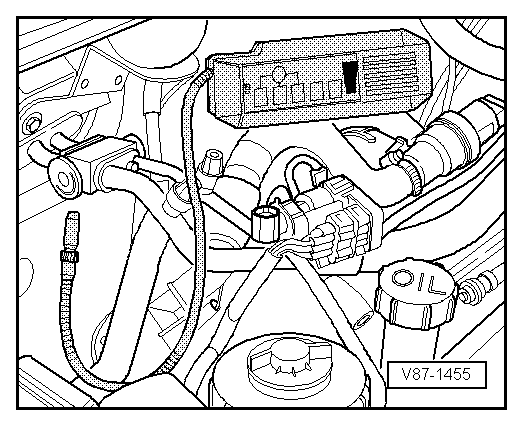Audi A4: Refrigerant Circuit, Tracing Leaks Using Electronic Leak Detector
Vehicles with a High Voltage System (Hybrid Vehicles)
Read and follow all of the supplemental warnings for all work performed on vehicles with the high voltage system. Refer to → Chapter "Warnings when Working on Vehicles with High Voltage System" and → Electrical Equipment; Rep. Gr.93; General Warnings when Working on High Voltage System.
All vehicles
 Note
Note
- The various refrigerants have differing molecular compositions. The electronic leak detector sensors are set up to detect these molecules. If an electronic leak detector is used, which is not specifically designed to detect refrigerant R134a, it will not respond to the refrigerant R134a or will only do so when there is a larger concentration of R134a in the area of the leak.
- Depending on the version of the A/C unit, an evaporator leak can be determined either by holding the leak detector test probe over the glove compartment cooling connection in the A/C unit, or by holding the test probe on an open connection of a disconnected A/C condensation water hose.
Perform a leak detection test to locate the leak while the refrigerant circuit is completely empty:
 Caution
Caution
To prevent more refrigerant than is necessary for the leak test from venting into the air, proceed as follows with the refrigerant circuit completely empty:
- Evacuate the refrigerant circuit with the A/C service station. Refer to → Chapter "Refrigerant Circuit, Discharging with Service Station".
 Note
Note
- If a larger leak is found during evacuation, find and it and repair it as described. Refer to → Chapter "Refrigerant Circuit, Discharging with Service Station".
- If no leak is found during evacuation or there is a leak that is so small that the location cannot be found with the vacuum test, proceed as follows.
- Fill the evacuated refrigerant circuit with approximately 100 grams of refrigerant and perform the leak test in the same way as for a refrigerant circuit that is filled with refrigerant.
Perform a leak detection test on a refrigerant circuit that is filled with refrigerant:
- Turn off the ignition.
- Start up the leak detector in line with relevant operating instructions.
- Always hold the test probe underneath the suspected leak.
Depending on the model, leak detection is indicated by an increase in clicking rate or a warning tone. Refer to operating instructions for leak detector.
 Note
Note
- Currents of air quickly disperse refrigerant gas. Draughts must therefore be avoided during leak detection.
- Refrigerant gas is heavier than air and will escape.


